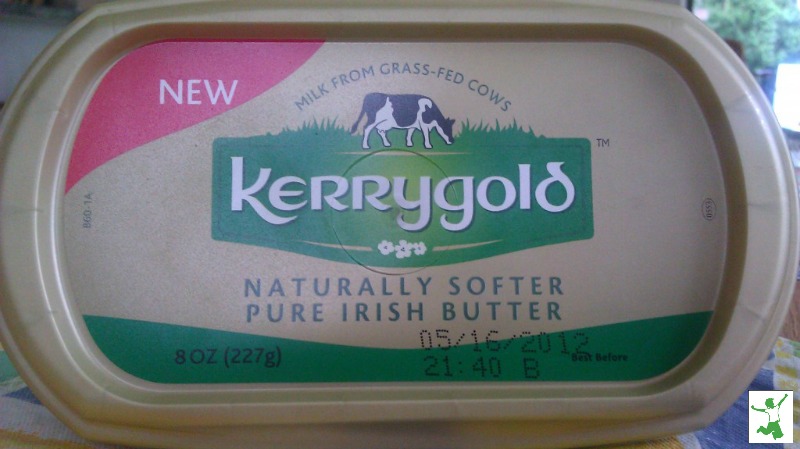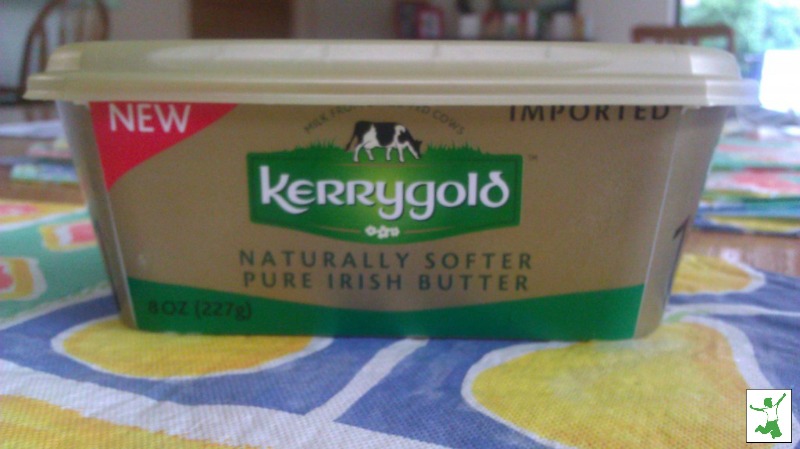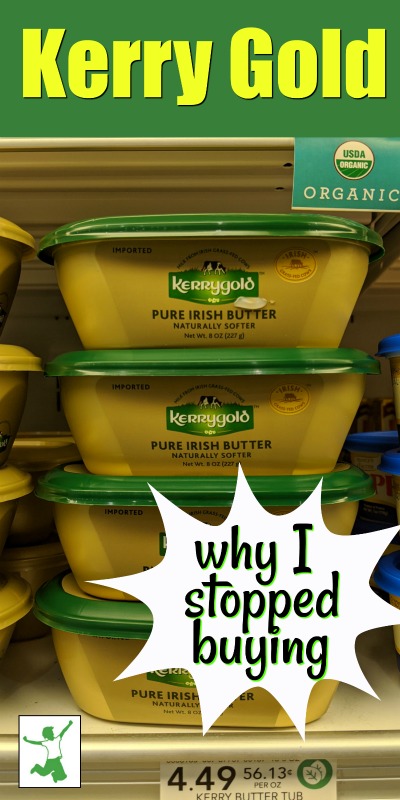Table of Contents[Hide][Show]
Kerrygold is marketed as grass-fed and all-natural, but the tub butter has concerning ingredients, dangers and marketing ploys to consider before buying.

Kerrygold, without question, is probably one of the best store butters you can buy. I myself have been using it for years for cooking.
The milk is from grass-fed cows and even though the cream used to make Kerrygold Butter is pasteurized, it is the best choice available to most folks who do not have access to raw butter from a small farm or who simply don’t want to use their precious raw butter for cooking.
I also know that many of you out there use Kerrygold too. When I conducted a Butter Poll on this blog awhile back, by far the most used butter (out of 1,500 or so total votes) was Kerrygold which received way more votes than even Organic Valley butter.
So what’s the problem?
My husband brought home the “new” Kerrygold butter the other day. On the surface, it looked fine. Nowhere on the outside of the package was there any indication that there was a problem with this butter. Here’s what it looks like.

I got suspicious with the “new” label, however. There’s nothing “new” about butter. That’s what I like about it after all!
Another tip-off that there was a problem lurking was the proclamation on the label that this “New Kerrygold” was “naturally softer”.
When I first saw the “naturally softer” words, I thought that meant that the butter was whipped and hence more spreadable. I don’t know about you, but I don’t want air whipped into my butter. This is a surefire way to get less product and get charged the same price for the privilege if you know what I mean.
I made a mental note to tell my husband not to buy this butter again because it was whipped and not as good a value.
But then, it got way worse…
Is Kerrygold Butter Grass-fed?
I took off the lid to the new Kerrygold package and saw the following words:

I had become a victim of the Big Fast One!
Kerrygold is stealthily selling LOWFAT butter and guess what? You get to pay the same price for the cheaper quality!
NOWHERE on the outside of the label did it say that the butter was low-fat. The ingredients said simply: pasteurized cream and salt the same as the commercialized Amish butter at the supermarket.
I daresay that this marketing ploy will be fooling a lot of folks who desire to buy full-fat grass-fed butter.
It seems that some butter brands have adopted what companies making substitutes for butter have been doing for years.
I have become very tuned in to these labeling tricks and manufacturer games over the years. When it comes to packaging, I double-check the ingredients along with the manufacturing processes every few months. This is even for products that I’ve been buying for years.
But how many people really do this?
Ingredient Bait and Switch
You NEED to be doing this!
Manufacturers are changing ingredients and packaging all the time! The primary intent of these “improvements” is to increase product sales and profitability. Your health is, sadly, of little to no concern in the grand scheme of things.
Reducing the fat content in its butter will skyrocket profits for Kerrygold as they will make the same per unit for the butter and yet be able to sell the skimmed cream to other companies to make ice cream or whatnot thereby increasing revenue substantially.
If you buy Kerrygold, I’m not telling you to stop buying it. I’m only telling you to beware of this new packaging nonsense and be sure what you buy is what you intend: full-fat butter!
By the way, if you are wondering why I love full-fat butter, you might want to educate yourself on the low-fat scam by learning about the history of butter vs margarine in the United States.
As for me, I will be returning this product to the store for a full refund. It is falsely advertised after all. I had no way of knowing it was a low-fat product until I opened it.
Manufacturer Response
I received this email from Kerrygold following the widespread sharing of this article. I find it very hard to believe that my blog suddenly brought this packaging error to their attention.
Do they have NO ONE on the production line in charge of quality control? This was not a difficult problem to identify. Could we have a bit of spin going on here? Perhaps so.
Dear Sarah,
Your blog has brought to our attention a packaging error of which we were unaware. While Kerrygold does sell a Reduced Fat & Sodium Butter the pack you show on your blog is 100% full fat butter which has been packed with the incorrect inner seal. There is no deliberate intent on our part to mislead our valued consumers or to misrepresent our product although we regret the confusion this is clearly creating.
We are working to identify how much product has been released into the market with the incorrect packaging so that we can replace it as soon as possible. In the meantime we would appreciate your assistance in clarifying the misunderstanding to your readers. We would love to provide further clarity — our email is [email protected] — and we are happy to answer any specific questions you and your readers may have in relation to the product.
With thanks & regards,
The Kerrygold Team
Why I No Longer Buy Kerrygold
I wanted to let all of you know that I no longer buy even the traditional Kerrygold brick butter in foil packaging. Why? A good friend visited Ireland and traveled extensively to a number of grass-based dairy farms.
This credible source told me that while the cows that provide cream for the Kerrygold butter are definitely on pasture and hence “grass-fed”, they receive supplemental GMO animal feed as well especially during the winter months. The local community and citizenry in Ireland concur and will tell you as much if you are in the area.
So, the word on the street is that Kerrygold is not legitimately pastured either.
Butter from cows that get GMO feed introduces the very real possibility of Roundup residue in the butter.
Thanks but no thanks!
While I have not been able to confirm this story 100%, I trusted the credibility of the information enough to permanently switch to another brand (I currently use this one).
I use this butter for cooking in addition to the homemade pastured raw butter I make for non-cooking purposes.
I also no longer recommend Kerry Gold in my Shopping Guide.
What about Organic Valley butter as an alternative to Kerry Gold? While I am not happy about Organic Valley’s policy that disallows member farmers to sell raw milk on the side to their community (treating them more like medieval serfs than the independent business owners that they are), I find this less onerous than deceptively feeding animals GMO feed without clearly informing the end consumer.









I just emailed them and they said it was a labeling error. They are still going to sell the bricks!!! 🙂
Wonder what the “special process” involves since I would think churning is churning isn’t it?
by the way, does anyone know if kerrygold homogenized??
my whole world just flipped upside down,
-jason and lisa-
No, milk is homoegenized not butter. You are good.
I didn’t know this!
from their website, “Our Naturally Softer Butter is unlike anything else in the world. The milk Kerrygold cows produce in the summer months are highest in naturally softer milkfat. We use a special process to gently churn this summer milk to create a softer, more spreadable natural butter.”
i have also seen the lofat butter at whole foods.. i would be open to the idea that this was an accident however, i will be carefully watching.. who can blame anyone for being upset about this.. food companies do this all the time.. Sarah, you seem to be more in “the know” than the average person!! if you find that kerrygold shouldnt be used anymore or would reccomend another brand, please blog about it.. i cant speak for everyone else here but Sarah is a household name around here.. my family follows this blog nearly word for word..we are really good at doing our own research but sometimes things slip through the cracks.. having other informed consumers out and about who know how to look for these things and arent afraid to point fingers and yell always helps!!
a bit upset,
-jason and lisa-
I will be keeping my eye on the situation. Kerrygolds answer above in the comments is that it was an inadvertent packaging error. This concerns me as this indicates poor quality control as this is not a hard problem to identify. I will not be buying spreadable kerrygold in tubs even if full fat but will stick with their original butter in foil wrapping. If this is eventually phased out, I will stop buying kerrygold altogether. That’s where I stand for now at least 🙂
Do I misunderstand you if I think you are saying they really put lowfat butter in the tub and advertising it as regular butter? I can see how human error, or humans-operating-packaging-machinery error can occur in this case. My relatives own manufacturing businesses, and I have seen myself. Nothing is 100% foolproof. With all due respect, I’d give them some grace. 🙂
Kerrygold’s Reply…Dear Rob,
You are correct; unfortunately, there has been a packaging error on our part in Ireland. There have been some Naturally Softer Butter packages that have received the inner seal that is meant for the Reduced Fat Butter. Unfortunately, we have just discovered this today. The seal is just there to ensure absolute freshness of the butter and happens to give us some real estate to talk additionally about the butter.
We are working quickly to resolve the issue and to get a handle on how many packages may be affected by this packaging error.
We want to ensure you that we would never deceive our valued consumers.
@Janelle No thanks. A farmer I am not. I trust people not companies which is why I attempt to source as much of my food locally as possible.
@Winnie I appreciate and respect your perspective. I do think there is value in these types of posts nonetheless.
Please express your opinions to Kerrygold USA. It would be good for them to know that not everyone in the US admires lowfat butter!!
Please forgive me if this has already been mentioned in the comments (I did not have time to read all of them!). Even if the butter in the tub is the same, why have they chosen to use more packaging (an entire plastic tub with foil seal) rather than the normal bricks packed simply with a foil wrapper? I would think that the foil-wrapped bricks have a lesser environmental impact than a plastic tub.
I always thought the softer butter in the tub is packaged for spreading directly onto toasts etc, (so it stays in the tub for easy storage) whereas the foil-wrapped ones are packaged for cooking (measure, cut, add to ingredients). This makes sense to me.
Just adding 3 cents. I leave a bit of KG (and sometimes conventional if money is tight) butter out every week on the countertop (salted). That way, it’s always soft for toast or bread. It’s never spoiled or soured. I use it up within 2 weeks max. I have never purchased a whipped butter because it costs more for fewer ounces. So that is my tip. Butter can be left out on the counter top to get soft and it won’t get gross. In the high heat of summer time, the oil might separate from the solids, so keep it in a dish.